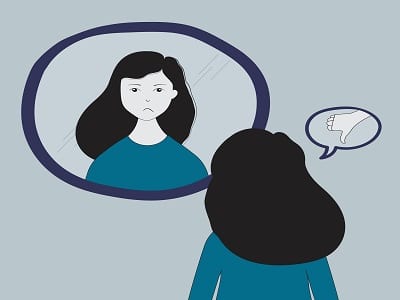Understanding Body Dysmorphia and Body Image Issues
Body image refers to the way a person perceives his or her appearance and how they believe others see them. How a person thinks and feels about their body directly affects their self-esteem, confidence, and motivation.
The diagnostic and statistical manual of mental disorders (DSM-5) classifies body dysmorphic disorder as preoccupation with an imagined defect in appearance. This imagined defect presents as a physical abnormality in a person’s appearance.
…body dysmorphic disorder is a serious mental health condition with potentially severe consequences. American Psychiatric Association
Body dysmorphic disorder is a mental health disorder, also referred to as body dysmorphia or muscle dysmorphia. Somatoform disorders can also include body dysmorphic disorder.
What is the Cause of Body Dysmorphic Disorder?
The cause of body dysmorphic disorder is thought to be a combination of biological, psychological, and environmental factors.
Getting Help for Body Dysmorphic Disorder
If you have body dysmorphic disorder it will warrant the help of a trained mental health professional or healthcare provider to provide medical advice. This disorder can cause severe emotional distress. The prevalence and clinical features will vary for each individual.
Personality Traits of Body Dysmorphic Disorder
- Dissatisfaction with your body
- Constantly worry about your body shape
- Negative image of your body
- Body image disturbance that takes over
- Social anxiety disorder around your appearance
Understanding Body Dysmorphic Disorder
A negative image of your body at times or being dissatisfied with your appearance is different than being hyper-focused on a specific body part. This hyper-focused fixation often occurs with body dysmorphic disorder (BDD).
BDD is an obsessive pathological disorder where a person fixates on a particular body part or slight defect, viewing it as seriously flawed. The supposed “flaw” may not even be real, or, if it is real, it may be so insignificant that it is unnoticeable to others.
A person with BDD is so consumed with the perceived imperfection, they often experience emotional issues, problems with social situations and interpersonal relationships, and difficulty meeting school or job responsibilities.
Negative Body Image
People with a healthy image of their body are accepting of and comfortable in their bodies. They are more confident in social interactions, sports, and other activities and are more likely to be physically and mentally healthy.
Those with a distorted or negative body image have an unrealistic view of their body, especially when they believe that their size, shape, is lacking compared to others. Individuals with a negative image of their body are more likely to develop disordered eating, depression, mental health conditions or certain personality traits.
A negative depiction of your body can contribute to serious social and mental health disorders, including:

- Depression and anxiety
- Low self-esteem
- Social anxiety
- Feelings of being judged by others based on appearance or a perceived defect
- Higher risk of substance abuse
- Self-consciousness in intimate and other interpersonal relationships
- Perfectionistic tendencies
- Repetitive negative thoughts
- Increased risk of suicidal thoughts
Body Dysmorphic Disorder
Those suffering from body dysmorphic disorder (BDD) experience severe emotional problems over their perceived defect. Although they constantly seek reassurance from others about how they look, they are unable to believe people who say they look fine.
A person with BDD is so preoccupied with one or more perceived flaws in their appearance that they become incapable of functioning normally. They may repeatedly check their appearance in the mirror and spend hours grooming to conceal their perceived flaws. They may feel too anxious or embarrassed to interact socially, fearing others will notice their imperfection.
People Suffering from BDD
People suffering from BDD are constantly searching for a way to correct their perceived imperfection, often undergoing cosmetic procedures. While the cosmetic procedure may provide temporary relief, the individual quickly becomes dissatisfied with the results and begins looking for another way to fix their flaw.
Common Areas of Perceived Imperfections
The most common areas of perceived imperfections include the nose, hair, skin, breasts, hips, stomach, muscle size, genitalia, and complexion.
Studies have found women with BDD are most dissatisfied with their skin, hips, and weight, while men are more focused on thinning hair, the size of their genitalia, and their overall physique.
Research Finds BDD Affects Men and Women equally.
Research finds BDD affects men and women equally. The disorder most often begins during the adolescent and teen years, frequently between 12 and 13 years of age.
Pressure from peers and a society that equates physical appearance with beauty and value also can have an impact on the development of BDD. If you have a family history of body dysmorphic disorder you may be at an increased risk for developing it.
If you have gone through negative experiences during childhood, traumatic events, or emotional conflict you may have developed body dysmorphic disorder.
A Subset of BDD that Affects more Men
Muscle dysmorphia is a subset of BDD that affects more men than women, characterized by an obsessive effort to increase muscle size and definition.
Warning Signs of Body Dysmorphic Disorder (BDD)
The following are warning signs of body dysmorphic disorder (BDD), according to the Mayo Clinic:

- Obsessive preoccupation with a perceived flaw in appearance that others do not see or view as minor
- Firm belief that the “defect” makes them ugly or deformed including body hair
- Belief that others are mocking their appearance
- Obsessing about skin imperfections or body odors
- Engaging in behaviors aimed at fixing or hiding the perceived flaw that is difficult to resist or control, such as frequently checking the mirror, grooming, or skin picking
- Attempting to hide perceived flaws with styling, makeup, or clothes
- Seeing many mental health professionals about your appearance
- Constantly comparing their appearance with others
- Social isolation or having a social phobia
- Mental illness including major depression or related disorders
- Seeking constant reassurance about their appearance from others
- Being a perfectionist
- Seeking plastic surgery but being dissatisfied with results
- Avoiding social situations
BDD and Obsessive-Compulsive Disorder
Although BDD and obsessive-compulsive disorder (OCD) have different diagnostic criteria, the symptoms often overlap. It is not uncommon for a person to suffer from both OCD and BDD.
Symptoms of both include persistent obsessive thoughts that are distressing and uncontrollable, repetitive behaviors, and a preoccupation with symmetry and perfection.
One of the key differences between the two disorders is that a person with BDD focuses obsessively on facial or body features, while the obsessions of those with OCD vary widely.
BDD and Eating Disorders
It is common for people with certain disordered eating to also suffer from body dysmorphic disorder. According to the Anxiety and Depression Association of America, if you suffer from BDD, you may also suffer from social anxiety disorder , depression, or other mental health disorders .
Individuals diagnosed with anorexia nervosa, bulimia, or binge eating have a negative body image and may obsess about certain aspects of their appearance. They are prone to comparing their appearance with others, have low self-esteem, and may engage in strict eating rituals, excessive exercise, and other compulsive behaviors.
People diagnosed with both disordered eating and BDD may exhibit more severe mental or behavioral disorders than those diagnosed with only one disorder. As with any dual diagnosis, it is important that both disorders are treated simultaneously.
Is Body Dysmorphic Disorder an Eating Disorder?
Body dysmorphic disorder (BDD) shares some features with disordered eating and obsessive-compulsive disorder (OCD). Body dysmorphic disorder other disorders around eating are similar because they both involve some sort of concern with your body or appearance.
If you suffer from OCD, you have unrealistic thoughts, perceptions and fears that lead to repetitive behaviors. This relates to body dysmorphic disorder because you will fixate on a body part, and it effects your behaviors.
How is Body Dysmorphic Disorder Diagnosed?
Body dysmorphic disorder may be diagnosed by a healthcare provider or mental health professional. Most professionals will go over your risk factors and will monitor your symptoms. Your response, prevention, and body image dissatisfaction will determine the extent of the disorder.
To be diagnosed with body dysmorphic disorder:
- You must be abnormally concerned about a small or nonexistent perceived flaw
- Your negative thoughts about your perceived flaw must be severe enough that they interfere with your ability to live normally
- Other mental health conditions must be ruled out as a cause of your symptoms, such as severe depression or anxiety disorders
How is Body Dysmorphic Disorder Treated?
Many studies support a combination of cognitive-behavioral therapy (CBT), including exposure therapy, and medication, usually an SSRI antidepressant, as effective treatments for BDD.
During exposure therapy, the patient must face their fear without being able to respond in their usual manner. For example, the person must appear in public without first checking and rechecking themselves in a mirror. As the patient continues to face their fear, the less distressed they feel.
There are Ways to Help Prevent Body Dysmorphic Disorder
There are ways to help prevent body dysmorphic disorder (BDD) from taking over your life. Many studies support a combination of cognitive behavioral therapy for treating body dysmorphic disorder, including exposure therapy, and medication, usually selective serotonin reuptake inhibitors (SSRI’s). Antidepressants can be effective treatments for body dysmorphic disorder.
Therapy can Help
Therapy can help develop healthy and realistic attitudes toward your self-esteem and image of body. During exposure therapy, the patient must face their fear without being able to respond in their usual manner.
For example, the person must appear in public without first checking and rechecking themselves in a mirror. As the patient continues to face their fear, the less distressed they feel.
BDD is a Serious but Treatable Disorder
BDD is a serious but treatable disorder. It is vital that a person with body dysmorphic disorder (BDD) receives treatment from a qualified mental health professional. Without treatment, symptoms often worsen over time and may cause severe depression and suicidal thoughts and actions.
If you have suicidal thoughts, get help immediately from a healthcare provider.
- Call 911 or your local emergency number.
- Call the National Suicide Prevention Lifeline at 1-800-273-TALK (1-800-273-8255) or contact the Lifeline Chat.
- Call your doctor or mental health professional.
Eating Disorder Treatment at Turning Point of Tampa
Turning Point of Tampa has been offering Licensed Residential Treatment for Addiction, Eating Disorders and Dual Diagnosis in Tampa since 1987.



